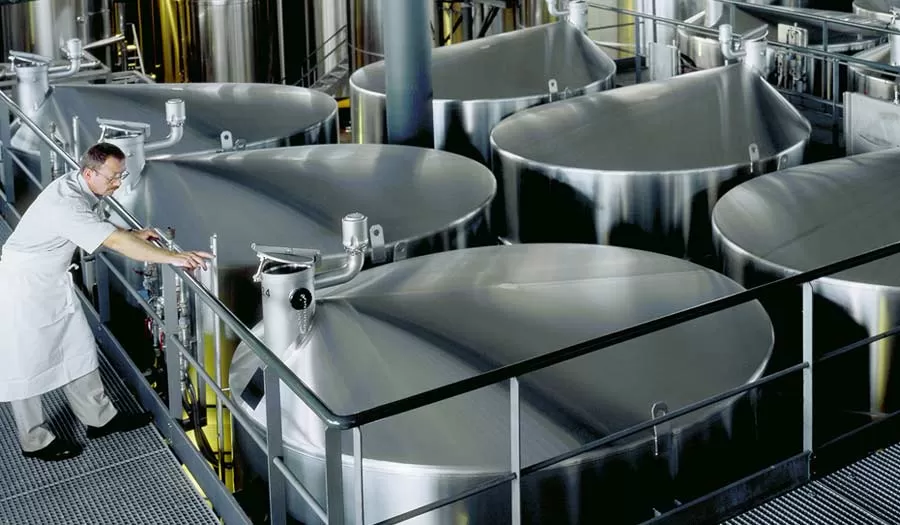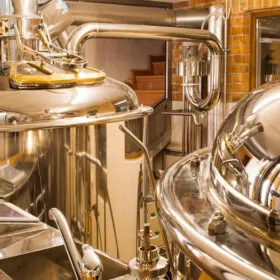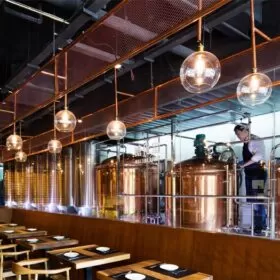When it comes to brewing beer, having the right equipment is crucial. One essential component of any brewery is the brewery tanks. These tanks play a vital role in the brewing process, ensuring the quality and consistency of the final product. In this article, we will explore the different types of brewery tanks for sale available, factors to consider when choosing the right tanks, the benefits of investing in quality equipment, and maintenance tips for keeping your tanks in optimal condition.
Introduction
Brewery tanks are specialized containers designed for various stages of the brewing process. They are built to withstand the unique requirements of brewing, including temperature control, pressure regulation, and sanitation. Without proper brewery tanks, it would be challenging to achieve the desired beer quality consistently.
Importance of Brewery Tanks in the Brewing Process
Brewery tanks play a crucial role in the brewing process, offering a range of benefits that contribute to the creation of high-quality beer. Understanding their importance can help brewers appreciate the significance of investing in the right tanks for their operations.
Fermentation Tanks
Fermentation is the heart of brewing, where yeast works its magic by converting sugars into alcohol and producing carbon dioxide. Brewery tanks, specifically fermentation tanks, provide the ideal environment for this process. These tanks are designed to control temperature, pressure, and other variables that influence yeast activity.
During fermentation, yeast consumes sugars and produces alcohol, esters, and other flavor compounds. The controlled environment of fermentation tanks allows brewers to manipulate factors such as temperature and yeast strain to achieve specific flavor profiles. This stage is where the beer’s unique characteristics begin to develop.
Bright Beer Tanks
Once fermentation is complete, the beer undergoes clarification to remove any remaining sediment or haze. Bright beer tanks, also known as maturation tanks, play a key role in this process. These tanks enable the settling of yeast and other particles, resulting in a clear, visually appealing final product.
Bright beer tanks facilitate the separation of beer from sediment through the use of fining agents or filtration methods. The beer becomes brighter, improving its appearance and stability. Clarification is especially important for beers that will be packaged and distributed, ensuring a consistent and visually appealing product for consumers.
Conditioning Tanks
After clarification, some beers benefit from additional aging and conditioning. Conditioning tanks provide the optimal environment for this stage of the brewing process. During conditioning, the beer continues to mature, allowing flavors to develop further and harmonize.
Conditioning tanks often have cooling capabilities to control temperature and maintain consistent conditions over an extended period. This controlled aging allows flavors to meld and mellow, resulting in a more refined and balanced beer. Conditioning can enhance the complexity and depth of the final product.
Serving Tanks
Once the beer is fully conditioned and ready for consumption, it needs to be served to customers. Serving tanks, also referred to as serving vessels or kegs, fulfill this important role. These tanks store the beer under proper pressure and temperature conditions, ensuring that it remains fresh and carbonated.
Serving tanks are designed to preserve the beer’s quality, preventing oxidation and maintaining its desired carbonation level. They provide a reliable and convenient means of storing and dispensing beer to customers in bars, restaurants, or other venues. Serving tanks ensure that the beer reaches the consumer in the best possible condition, delivering an enjoyable drinking experience.
In conclusion, brewery tanks are of utmost importance in the brewing process. From fermentation to conditioning and serving, these tanks provide the necessary environments and functionalities to produce high-quality beer with distinct flavors, clarity, and carbonation. Investing in well-designed and properly maintained brewery tanks is essential for brewers seeking to create exceptional beers that delight consumers.
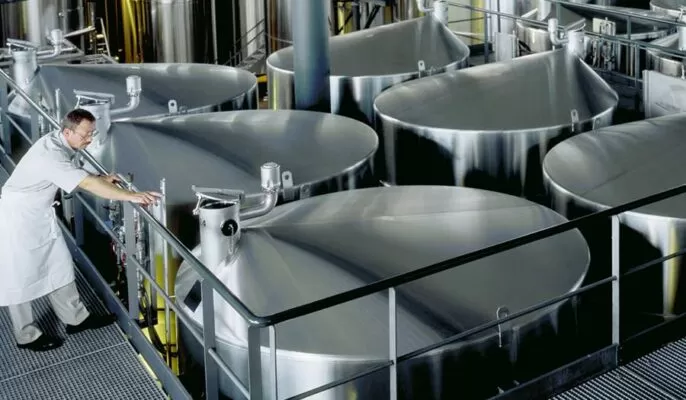
Types of Brewery Tanks
When it comes to brewery tanks, there are several types that play essential roles in the brewing process. Each type serves a specific purpose and contributes to the overall quality and taste of the beer. Let’s explore the different types of brewery tanks:
Fermentation Tanks
Fermentation tanks are the heart of any brewery. They are where the magic happens, where the yeast transforms the sugars in the wort into alcohol and carbon dioxide, giving the beer its distinct flavors and aromas. Fermentation tanks provide a controlled environment for this process to take place. They come in various sizes and shapes, allowing breweries to cater to their specific production needs. These tanks are often made of stainless steel, which is ideal for maintaining cleanliness and preventing any unwanted interactions with the beer.
Bright Beer Tanks
Once the fermentation process is complete, the beer needs to undergo clarification before it can be packaged. This is where bright beer tanks, also known as maturation tanks, come into play. Bright beer tanks allow the beer to settle and clear up, removing any remaining sediment or haze. They typically have a bright and polished interior surface, which helps enhance the beer’s clarity and appearance. Bright beer tanks often have additional features like carbonation stones or pressure systems to adjust the carbonation levels of the beer. These tanks ensure that the beer is visually appealing and ready for packaging.
Conditioning Tanks
Conditioning tanks are used for the secondary fermentation and conditioning of the beer. After the primary fermentation in the fermentation tanks, the beer is transferred to conditioning tanks for further maturation. Conditioning tanks provide a controlled environment where the beer can age, allowing it to develop more complex flavors and achieve the desired level of carbonation. These tanks are often equipped with cooling systems to maintain the ideal temperature for conditioning. Conditioning tanks play a crucial role in refining the beer’s taste and ensuring a well-rounded flavor profile.
Serving Tanks
Once the beer is fully conditioned and ready to be served, it is transferred to serving tanks. Serving tanks, also known as serving vessels or kegs, are responsible for storing and dispensing the beer to customers. These tanks are designed to maintain the freshness and carbonation of the beer, ensuring that it tastes as intended when it reaches the consumer’s glass. Serving tanks come in various sizes, ranging from smaller kegs for individual consumption to larger vessels for commercial establishments. They are equipped with features such as pressure gauges and taps to provide ease of use and a reliable dispensing system.
Each type of brewery tank plays a crucial role in the brewing process, from fermentation to conditioning and finally serving the beer. Choosing the right tanks for your brewery is essential to ensure optimal beer quality and production efficiency. Whether it’s the controlled environment of fermentation tanks, the clarity-enhancing properties of bright beer tanks, the flavor development in conditioning tanks, or the final presentation in serving tanks, each type contributes to creating the perfect brew.
Factors to Consider
When choosing brewery tanks for your brewing operation, several factors should be taken into consideration. These factors will help you select the right equipment that suits your specific needs and ensures optimal performance.
Tank Size and Capacity
The size and capacity of brewery tanks are crucial considerations. You need to determine the volume of beer you plan to produce and the frequency of brewing. Choosing tanks that can accommodate your current needs while allowing room for future growth is important. It ensures that you have the necessary capacity to meet increasing demand without requiring immediate tank replacements.
Material and Construction
The material and construction of the tanks significantly impact their durability and performance. Stainless steel is widely favored in the brewing industry due to its corrosion resistance and ease of cleaning. It provides a hygienic and robust environment for beer production. Ensure that the tanks you choose are well-constructed, featuring sturdy welds and reliable fittings. This ensures longevity and minimizes the risk of leaks or structural failures.
Cooling and Insulation
Temperature control is vital throughout the brewing process, and brewery tanks should offer efficient cooling and insulation capabilities. Consistent and precise temperature management is essential for achieving desired fermentation and conditioning results. Look for tanks equipped with reliable cooling systems that can effectively regulate temperature levels. Additionally, proper insulation helps prevent heat transfer, maintaining stable temperatures and improving energy efficiency.
Pressure and Safety Features
Brewery tanks operate under pressure during various stages, such as carbonation and storage. It’s crucial to choose tanks that can withstand the desired pressure levels without compromising safety. Look for tanks equipped with reliable pressure relief valves and safety features. These mechanisms ensure that excessive pressure is released safely, minimizing the risk of accidents or tank failure.
Cleaning and Maintenance
Maintaining clean and sanitized tanks is vital for producing high-quality beer and preventing contamination. Consider the ease of cleaning and maintenance when selecting brewery tanks. Look for tanks with smooth interior surfaces that are easy to clean, minimizing the risk of bacterial growth or residue buildup. Tanks with clean-in-place (CIP) capabilities streamline the cleaning process, allowing for efficient and thorough sanitation. Additionally, ensure that the tanks have easy access points for inspection, making routine maintenance tasks convenient.
By carefully considering these factors, you can make an informed decision when choosing brewery tanks for your operation. This ensures that the tanks you select are well-suited to your production needs, promote quality beer production, and offer longevity with proper maintenance.
Choosing the Right Brewery Tanks
Selecting the right brewery tanks requires careful consideration and evaluation. Here are some steps to guide you through the process:
- Assess Your Brewing Needs: Determine your production goals, volume requirements, and specific brewing processes. This assessment will help you identify the types and quantities of tanks you need.
- Budget Considerations: Define your budget for brewery tanks and consider the long-term return on investment. While quality tanks may have a higher upfront cost, they can provide better performance and longevity.
- Work with Reputable Manufacturers: Research and collaborate with reputable manufacturers who have a track record of producing high-quality brewery tanks. They can provide valuable guidance and ensure the tanks meet your specifications.
- Consult with Industry Experts: Seek advice from experienced brewers or consultants who have expertise in brewery equipment. They can offer insights and recommendations based on their industry knowledge.
- Evaluate Long-Term Costs and Benefits: Consider the operational costs, maintenance requirements, and potential expansion opportunities when selecting brewery tanks. Evaluate the overall benefits and long-term value they bring to your brewing operation.
Benefits of Investing in Quality Tanks
Investing in quality brewery tanks can have numerous advantages for your brewing business. Let’s explore some of the key benefits:
Consistent Beer Quality
Quality tanks provide a stable and controlled environment for fermentation and conditioning, resulting in consistent beer quality. They help maintain the desired temperature, pressure, and sanitation levels, ensuring the flavors and aromas of your beer remain true to your recipes.
Increased Production Efficiency
Efficient brewery tanks optimize the brewing process, leading to increased production efficiency. They allow for precise control of temperature, pressure, and fermentation conditions, reducing the risk of off-flavors or batch inconsistencies. This efficiency can result in higher output and reduced brewing time.
Scalability and Flexibility
Investing in scalable tanks allows you to adapt and expand your brewing operation as needed. Quality tanks can accommodate future growth and production demands, giving you the flexibility to scale up your business without major equipment replacement
Improved Hygiene and Sanitation
Quality brewery tanks are designed with cleanliness and sanitation in mind. They have smooth surfaces that are easy to clean, preventing the buildup of bacteria and contaminants. Proper cleaning protocols, such as CIP systems, can be implemented more effectively with well-designed tanks, ensuring optimal hygiene and beer quality.
Enhanced Product Shelf Life
Maintaining the freshness and longevity of your beer is crucial for customer satisfaction. Quality brewery tanks help preserve the integrity of the beer by providing the ideal conditions for aging and storage. With proper temperature and pressure control, your beer can have an extended shelf life, reducing waste and ensuring a consistent taste experience for consumers.
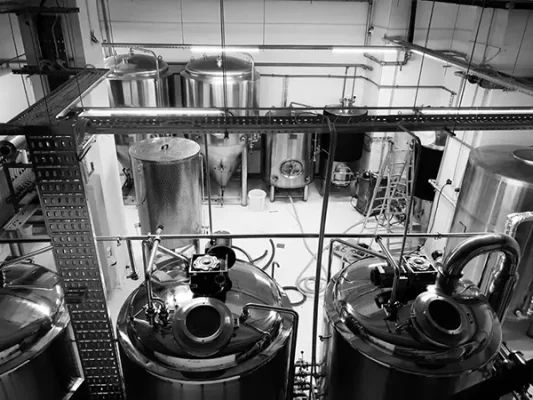
Maintenance and Care
To keep your brewery tanks in optimal condition and maximize their lifespan, regular maintenance and care are necessary. Here are some essential tips:
- Regular Cleaning and Sanitization: Implement a thorough cleaning and sanitization routine for your tanks, following industry best practices and guidelines. This helps prevent contamination and maintains the quality of your beer.
- Inspection and Maintenance Schedules: Establish a schedule for inspecting your tanks, checking for any signs of wear, leaks, or damage. Perform routine maintenance tasks such as tightening fittings, replacing gaskets, and lubricating moving parts.
- Replacing Worn-Out Parts: Over time, certain components of your tanks may wear out and need replacement. Keep an inventory of spare parts and monitor the condition of crucial elements such as valves, seals, and temperature sensors.
- Monitoring Tank Performance: Regularly monitor the performance of your brewery tanks, including temperature control, pressure regulation, and any indicators of potential issues. This proactive approach helps identify and address problems before they escalate.
- Upgrading and Expanding Capacity: As your brewing business grows, you may need to upgrade or expand your tank capacity. Plan for future expansion and work with manufacturers or consultants to assess your needs and make informed decisions.
Conclusion
Investing in high-quality brewery tanks is a critical decision for any brewing operation. The right tanks not only ensure the quality and consistency of your beer but also contribute to increased production efficiency, scalability, and improved hygiene. Regular maintenance and care are essential for keeping your tanks in optimal condition and maximizing their lifespan. By choosing the right tanks and implementing proper maintenance practices, you can set your brewery up for success and deliver exceptional beer to your customers.




